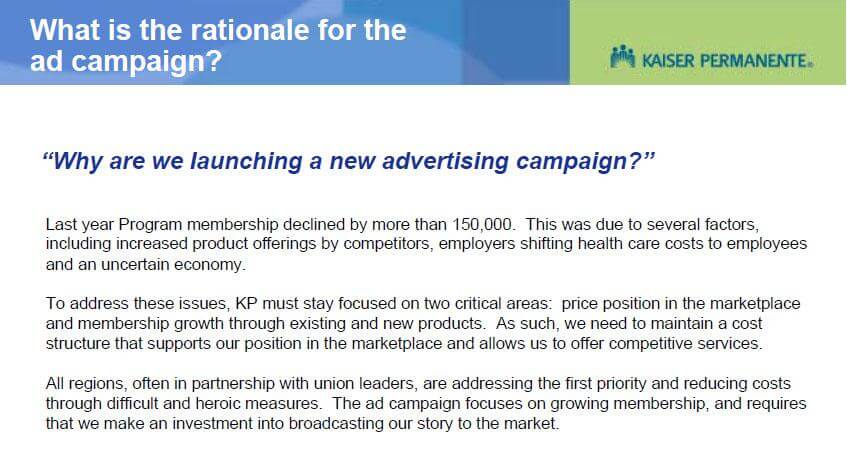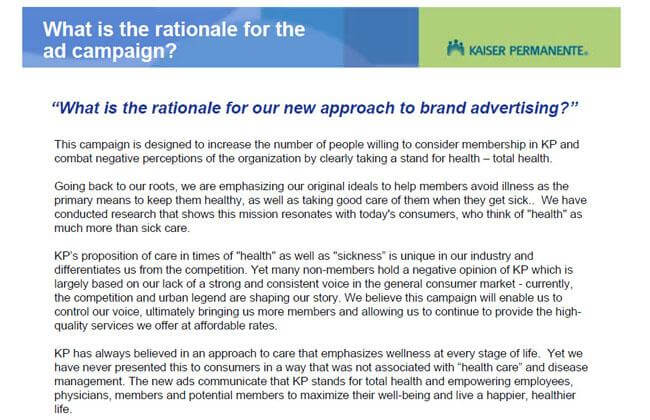For several decades, Kaiser Permanente, a large HMO based in Oakland, California, has spent tens of millions of dollars annually advertising on television, in magazines, and various other media. Kaiser, like other HMOs, traditionally promoted itself with the sorts of images you’d expect: a doctor treating a happy patient, a group of smiling doctors, and so forth. A Kaiser advertisement generally also spoke about the quality and number of its doctors. For just about every HMO out there, this was the advertising formula.
When meeting with Kaiser and discussing alternative approaches, advertising executives were asked:
- “Why shouldn’t we tell them how many doctors we have?”
- “Why shouldn’t we talk about how many hospitals we have?”
- “Doctors are the soul of what we do—we should talk about our doctors qualifications?”
- “People want to hear how well equipped our hospitals are. We should talk about that.”
If you’re like most people, the odds are pretty good you’re not wild about HMOs. Most people aren’t. HMOs have the reputation of providing a low standard of care and are for the most part distrusted by consumers.
Several years ago, Kaiser did a study and discovered that it attracted members who liked to go to the doctor frequently: Some of these people were constantly sick, others simply went to the doctor more often than they should. In fact, Kaiser had so many “chronically ill” people as members that it was having difficulty earning money.
Kaiser also had a shaky reputation among California consumers from a few high-profile scandals. There were several related to Kaiser allegedly cutting corners in providing care. Kaiser also required its plan holders to go to arbitration instead of filing a lawsuit, so that in several highly publicized cases, people who suffered egregious harm from Kaiser received minimal compensation for their injuries.
In addition to losing money, Kaiser was losing members due to its public relations issues and needed to take aggressive action to fix the problem. Marketing and positioning itself in the way it traditionally had would not help Kaiser. Being seen like other HMOs would also not help Kaiser. Kaiser needed to do something new and radical to change its image.
Kaiser was seen as a company out for itself—an anti-patient and anti-consumer company.
Kaiser’s doctors and hospitals were not trusted.
Kaiser needed to be perceived by the public as a different kind of company to save itself.
The way the world perceives us is incredibly important. It is something that celebrities, companies, and other professionals do their best to control. If a company, group, or individual is perceived the wrong way by the public then it may not succeed, but If this perception can be shifted to the positive, massive success can follow.
In the movie comedy Bruno, the title character (played by Sasha Baron Cohen) faces a massive public relations backlash after several negative episodes (in Europe he makes a fool of himself at a fashion show, in the United States he’s blacklisted after arranging a tasteless interview with Paula Abdul). In an attempt to rehabilitate his image, he visits a Los Angeles public relations agency and then sets out across the world to set things straight.
In the Middle East he attempts to bring Israel and Palestine together, meeting with terrorist leaders to negotiate a truce, then gets upset when he sees Bono has taken Darfur as a cause (one he’d have liked to claim himself). Finally, he decides to adopt an African child as a publicity stunt to rehabilitate his image.
Comical as they are, these episodes actually illustrate something quite legitimate: The power of positioning in how the public perceives us. Bruno wants to be seen as someone who helps the less fortunate and makes this part of his daily life. Nevertheless, these are the sorts of symbolic actions companies, individuals and others carry out all day in order to win the trust of others and shape our perception of them.
The actions people take can be large or small. Small actions often carry a lot of weight. In my last year of college I was president of my fraternity. The previous year I’d been treasurer of the fraternity, but my senior year I was not getting along with the new treasurer. In fact, we each disliked each other immensely. This made it difficult, because we shared many of the same friends. Each year our fraternity obligated its pledges to run several miles around the city of Chicago for several hours (don’t ask me why), and when these candidates for membership returned, they were predictably hungry and thirsty. Traditionally, the treasurer of the fraternity made sure that hamburgers and sodas were waiting when the pledges got back from their run.
The year I was treasurer, the pledges returned and I’d forgotten all about the event. (In fact, I think I was in the library studying!) When I got to the fraternity house later that night, a number of people were very upset with me, and for good reason. The next year, when my enemy was treasurer, he made a huge spectacle about having the hamburgers and sodas there, went completely overboard and ordered far more than were needed. Several people remarked how well it was done, and the treasurer made it clear to all that he was making up for how I’d screwed up the year before. This event, seemingly small on the surface, ended up undermining me. The strength of my enemy was only compounded as he used his position to demonstrate further shortcomings I’d demonstrated when I’d held the same job. He was quite a genius at making his point.
This is only a minor example, but it demonstrates the power of using small , symbolic actions to change the perception people have of you and others. My enemy was able to undermine me and make me look cheap while making himself look generous (though generous he was not). He did this symbolically and it was extremely effective.
This same thing occurs in the workplace. You can modify people’s perceptions of you by employing symbolic actions. Consider being perceived as a hard worker. Years ago when I was practicing law at a firm called Quinn Emanuel, being seen as a hard worker was considered a major attribute. Every Sunday most associates seeking to make partner would be in the office. But unlike other days they’d all congregate in the library instead of sitting in their offices. This did not make a lot of sense because the firm was on numerous floors. What this accomplished, though, was it allowed others to see them working and this helped shape their images as hard workers.
In a mark of brilliance, Kaiser and its marketing advisors (from the advertising agency Campbell-Ewald outside Detroit) developed a campaign called “thrive” where the company positioned itself as an advocate for fitness and healthy eating. Thus, instead of focusing on the doctors (whom the public had come to mistrust), the company portrayed itself as an advocate for good living. Under the thrive campaign the company emphasized images of people doing healthy things like exercising, eating healthy food, and meditating.
Prior to releasing the thrive campaign, Kaiser released the following document to its employees to help them make sense of this sudden about-face in its portrayal to the public:
According to one person I spoke with who helped conceptualize this campaign, there were several reasons for the decision to roll out the thrive campaign:
- First, by showing people doing healthy things, the company would be associating its brand with something that was appealing to consumers. People tend to think of sickness when they see doctors. People think of positive things when they see people engaged in healthy activities. Kaiser wanted to focus attention away from itself to more positive and uplifting images of healthy people.
- Second, by telling people to be healthy the company was portraying itself not as a cold and calculating HMO but as a company concerned about people’s welfare. The company wanted to be associated with being a force for health and good. It wanted to be associated with being a health advocate that did not cut corners.
- Third, the company wanted to attract healthy people and not sick people. A traditional advertisement that brags about the number of doctors an HMO has might be appealing to someone who is sick and enjoys going to the doctor, but it is unlikely to appeal to the sorts of healthy people Kaiser was attempting to attract. By attracting healthy people, Kaiser would have the added benefit of having to employ fewer doctors and being able to make higher profits.
- Fourth, Kaiser believed that its campaign would help the company to convince more employers to buy their HMO for their employees. The company marketed itself as a company that would help people be healthy and, by implication, would help employees become more productive. Productive employees mean more money for the company.
The ads were a stunning success. According to one healthcare publication, Media Health Leaders:
Since the campaign launched in 2004, Kaiser’s north and south California markets have seen double-digit increases in perception, which represents brand awareness and whether non-members are considering switching to Kaiser.
The success of the advertising campaign merits a lot of consideration. In one bold stroke (fueled by tens of millions of advertising dollars), Kaiser changed the direction of the company and improved its public perception by a huge magnitude. What it did was choose a series of symbolic actions (through advertising) to shape its image. While what Kaiser did is far more sophisticated than what I discussed above, it’s not that different from my hamburger or being-seen-in-the-library examples. We can shape how people see us in numerous ways.
Most of us are too involved in reacting to events as they happen in our day-to-day lives to pay a lot of attention to how we are ultimately perceived by others. Having an overall mission for our lives and an overall strategy is important because it defines us and who we are in the public eye. If we have a strategy for how we want others to see us, we can take various symbolic actions to shape this perception. Before Kaiser’s thrive campaign, it simply was seen as a group of doctors and hospitals out to earn money. After the thrive campaign, the same organization was defined as something else entirely.
What’s important about the thrive campaign is that after thrive, Kaiser was fundamentally still the same company. The only thing that had changed was the way the company portrayed itself to the world. It developed a strategy for how it wanted to be seen by others.
Most people are concerned with what’s most immediate to them. We think in terms of present events and move forward in life with a petty strategy. With a major strategy we can focus our actions so that we’re seen in the best possible light.
- Is your strategy to be seen as generous? Then take symbolic actions that allow you to be seen this way.
- Is your strategy to be seen as a hard worker? Then take symbolic actions that allow you to be seen this way.
- Is your strategy to be seen as powerful? Then take symbolic actions that allow you to be seen this way.
If you have a strategy for how you want to be perceived by employers and others, then you can shape this perception by consistently taking various actions that prompt others to see you in a certain light.
When Kaiser made the decision it wanted to be seen as an advocate for health, it started taking actions that were part of this overall strategy. It started sponsoring various athletic events like 5K runs. It started sending its members newsletters that emphasized healthy eating, exercise, and nutrition. Kaiser was able to shift the perception people had of it through a well-conceptualized strategy that built itself through advertising and then a series of symbolic actions.
We always try and look at what is most immediate to us and take the most immediate path toward what we are trying to achieve. If we want to earn a lot of money we may demand numerous raises, and, failing to get them may leave one employer for another. Instead, we might be better off having a long-term strategy that encompasses how our current employer needs to see us if we’re going to reach great heights of achievement there.
An interesting case is the law firm environment. Giant classes of associates start at law firms each year. Some of these law firms give associates the potential to earn millions of dollars per year if they stay on for the long term. But most people end up leaving these firms on their own volition. Distracted from their overall strategy, they think in small, micro-level terms:
- One partner does not like me.
- I did not appreciate being assigned that project.
- I did not get a good review.
- I am working too many hours.
- I am not getting enough work.
- My friends at other firms are making more money.
- There are problems with management in my firm.
There’s nothing wrong with leaving a firm in response to these sorts of issues, but most people out there are easily distracted by micro-level thinking and this ends up destroying—or severely limiting—their careers. You absolutely need a massive long-term strategy that is firm and does not get you distracted. Present events are often inconsequential to a long-term strategy. You need to think in terms of the broader, long-term strategy that you’re trying to achieve.
Consider Kaiser again. Faced with declining enrollments, many companies would not have approached this strategically. What most companies might have done is hired more sales people to sell insurance, demanded more productivity from their staff. Or, to cut costs, some companies might have instituted layoffs. None of these would have fixed the core problem that Kaiser was having in the marketplace. The problem was one of strategy and negative symbolism plaguing the brand.
Strategy takes into account the broader context. That context includes more than just your immediate situation. So be sure to expand your vision in all directions to understand the totality of the image you project and how you’re seen. Are your actions consistent with a strong overall strategy?
When something goes wrong (in business, in politics, in life), trace it back to the strategy (or lack thereof) that inspired it in the first place. Animals generally respond only in the moment. They do not think forward about how everything they do is part of a master strategy that determines how the world will view them. In having the ability to have a strategy, humans are far beyond animals in their level of sophistication. Humans have the ability to be strategic. You need to be strategic.






